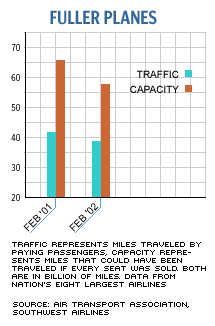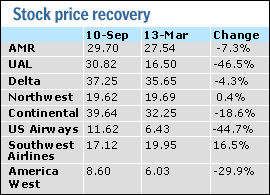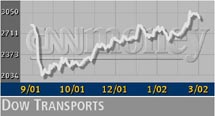
NEW YORK (CNN/Money) -
Planes are filling up, stock prices are on the mend and furloughed employees are being called back to work in advance of the summer travel season.
But six months after the Sept. 11 terrorist attack in which four commerical jetliners were hijacked, the U.S. airline industry remains deeply troubled with some carriers still near the brink of bankruptcy.
It might be tough for passengers to see the trouble as they squeeze into once-again full planes. Traffic reports from the nation's eight largest airlines show that 68.6 percent of their capacity was filled with paying passengers in February, a ratio known as load factor.
While that's off from the record 72.4 percent load factor achieved by the industry in 2000, it's better than the 66.4 percent of capacity for the same eight airlines in February, 2001. That's because airlines cut their capacity by 14 percent, which outpaced the 11 percent decline in miles flown by paying passengers.

But the passengers can see the airlines' woes when they book their tickets on those full flights. The amount paid by passengers for each mile traveled was off 15.6 percent in January compared to a year earlier, the most recent month for which figures are available from the Air Transport Association, the industry's trade group. Both of these trends are continuing into March and are expected to continue into the summer months as well.
"We are seeing some very heavy loads this month," said Al Becker, spokesman atAMR Corp.'s (AMR: Research, Estimates) American Airlines, the world's largest carrier. "It's a little early to predict the summer, but we're seeing encouraging signs. The problem the industry has is there's a lot of discount fares, and so we're not making money."

Airlines adding flights, recalling employees
American was among the carriers announcing deep staff and schedule cuts in the wake of Sept. 11. Many of the majors are now in the process of adding back both flights and staff. UAL Corp.'s United Airlines announced a recall of flight attendants as well as an increase in flights at its Chicago hub Tuesday.
On Wednesday, discount carrier Southwest Airlines, the only major carrier not to cut staff or flights in the wake of the attack, announced it would add five flights a day in June and accept delivery of two new Boeing (BA: Research, Estimates) jets deferred after the attack. Other carriers are also adding capacity, but all are also offering new fare discounts to try to fill those seats.

"We don't yet have traffic back where we need it, but yes, the problem (of losses) is primarily fares rather than traffic," said John Heimlich, director of economic and market research for the ATA.
American went from about 2,400 flights a day to 2,000 when it began flying again after the attack. The company also said it expected to cut 20,000 jobs, or about 20 percent of staff.
But the cuts never got deeper than 13,000 jobs, and starting in December it started to recall furloughed employees to meet slowing increasing operations. Today it is down about 8,000 to 10,000 employees from pre-attack levels, with 2,100 daily flights. By the time the summer travel season starts it expects to be up to 2,200 daily flights.
Losses could end later this year for many carriers
AMR Corp. is expected to post a first-quarter loss of $3.05 a share, according to analysts surveyed by earnings tracker First Call. That consensus loss forecast has been creeping up throughout the quarter and is up from the 28 cents a share loss in the first quarter of 2002, although it's down from the $4.75 a share loss in the fourth quarter.
Still, none of the eight largest carriers other than Southwest is projected to make money in the first quarter, and of the money losers only fifth-largest carrierContinental Airlines (CAL: Research, Estimates) is forecast to return to profitability in the second quarter. Those were also the only two carriers that had been expected to make money in 2001 before the terrorist attack.

But a return to more normal air travel demand is seen by the Federal Aviation Administration by 2003, and analysts are expecting that most carriers other than United parent UAL Corp., US Airways Group (U: Research, Estimates) and America West Airlines should be back flying in the black perhaps as soon as next year.
That means that even though most carriers' stock prices are just below their pre-attack levels, there are still buying opportunities for investors, said Ray Neidl, analyst with ABN Amro.
"The price-earnings multiple, based on future earnings forecasts, is still fairly low, in the 5 to 6 range," said Neidl. "These P/E multiples can go as high as 10. There's still some upside for most of them, except maybe Delta."
Industry watching United's concession effort
One development to watch is if United wins wage concessions from its unions. The world's second-largest airline is about to enter into talks with its unions to try to stem deep ongoing losses. If successful, other carriers may make a move to win pay cuts from their unions as well, although the carriers won't comment on such speculation at this point.
| |
 Related stories
Related stories
| |
| | |
| | |
|
"It's tough to know how we're going to respond," said American's Becker. "This is an extraordinarily competitive industry. If something occurs at a major competitor, we'll have to take a look at that."
The ATA's Heimlich said it'll be tougher for other carriers to win concessions if their financial situation is not as dire as United, but he would expect many to at least explore the issue with unions.
"I think it would certainly help if one leads the way (on concessions), there could be some domino effect," he said. "I think all labor groups are aware of what the problems are."
Click here for a look at airline stocks
Neidl also questions how successful even United will be in winning concessions needed to significantly change the industry's profit outlook.
"My best guess is that the unions will give them just enough to keep them out of bankruptcy, not enough to make them an attractive investment option," he said.

|

